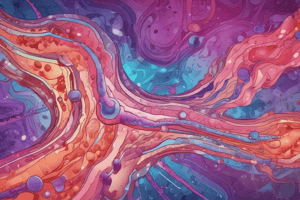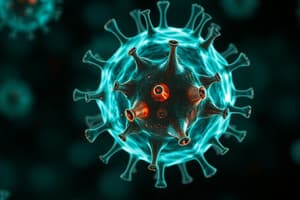Podcast
Questions and Answers
What type of molecules can inhibit heparinase?
What type of molecules can inhibit heparinase?
- Lipoxins
- Anti-proteases (correct)
- Endothelin
- Proteases
What is the characteristic feature of serous inflammation?
What is the characteristic feature of serous inflammation?
- Severe tissue destruction
- Outpouring of fluid (correct)
- Ulceration
- Fibrin deposition
Which of the following is NOT a clinical example of acute inflammation?
Which of the following is NOT a clinical example of acute inflammation?
- Asthma (correct)
- Lobar pneumonia
- Skin blister
- Abscess
What is the primary cause of pain in abscesses?
What is the primary cause of pain in abscesses?
What is the characteristic feature of acute inflammation in serous cavities?
What is the characteristic feature of acute inflammation in serous cavities?
What is the primary function of lipoxins in acute inflammation?
What is the primary function of lipoxins in acute inflammation?
What is the result of uncontrolled acute inflammation?
What is the result of uncontrolled acute inflammation?
What is the primary cause of tissue damage in skin blisters?
What is the primary cause of tissue damage in skin blisters?
What is the first step in the acute inflammatory response?
What is the first step in the acute inflammatory response?
What is the primary function of anti-proteases in acute inflammation?
What is the primary function of anti-proteases in acute inflammation?
Study Notes
Chemical Mediators of Acute Inflammation
- Proteases: plasma proteins produced in the liver, including kinins (bradykinin and kallikrein) and the complement system (C3a, C5a)
- Prostaglandins and leukotrienes: metabolites of arachidonic acid, synthesis blocked by NSAIDs (e.g. aspirin)
- Cytokines and chemokines: produced by WBCs, including interleukins, PAF, TNF alpha, PDGF, and TGF beta
- Other inflammatory mediators: from platelets (5-HT, histamine, ADP), neutrophils (lysosomal constituents), and endothelium (prostacyclin, nitric oxide, plasminogen activators/inhibitors)
Vascular Changes
- Three phases:
- Phase I: Immediate early response (1/2 hr), histamine released from mast cells, basophils, and platelets, causing vascular dilatation, transient increase in vascular permeability, pain, and not chemotactic
- Phase II: Immediate sustained response (not always seen), due to direct damage to endothelial cells
- Phase III: Delayed response (peaks around 3 hrs), many and varied chemical mediators, interlinked and of varying importance
Mechanisms of Vascular Leakage
- Endothelial contraction, leading to gaps, caused by histamine, leukotrienes, and cytokines (IL-1 and TNF, hypoxia)
- Cytoskeletal reorganization, leading to gaps, caused by cytokines (IL-1 and TNF, hypoxia)
- Direct injury, leading to toxic burns, chemicals, and leukocyte-dependent injury
- Increased transcytosis, leading to channels across endothelial cytoplasm, caused by VEGF (vascular endothelial growth factor)
Mechanisms of Neutrophil Migration
- Neutrophil adhesion and emigration, due to binding of complementary adhesion molecules on endothelial and neutrophil surfaces
- Chemical mediators changing surface expression or avidity of adhesion molecules
- Relaxation of inter-endothelial cell junctions, digestion of vascular basement membrane, and movement
- Chemotaxis, movement along concentration gradients of chemoattractants, involving receptor-ligand binding, rearrangement of cytoskeleton, and production of pseudopod
Functions of Neutrophils
- Phagocytosis, involving contact, recognition, internalization, and cytoskeletal changes
- Microbial killing, facilitated by opsonins, involving recognition, phagocytosis, and killing mechanisms (O2-dependent and O2-independent)
Consequences of Acute Inflammation
- Local complications: swelling, blockage of tubes, exudate, compression, pain, and loss of function
- Systemic effects: fever, leukocytosis, acute phase response, spread of micro-organisms and toxins, and shock
Resolution of Acute Inflammation
- Morphology: changes gradually reverse, vascular changes stop, and vessel permeability returns to normal
- Mechanisms of resolution: mediators have short half-lives, may be inactivated by degradation, bound by inhibitors, or diluted in the exudate, and specific inhibitors may be involved
Morphological Patterns of Acute Inflammation
- Serous inflammation: outpouring of fluid
- Fibrinous inflammation: severe destruction, either resolution or organization
- Suppurative purulent inflammation: abscess formation
- Ulceration
Clinical Examples
- Lobar pneumonia: caused by Streptococcus pneumoniae, affecting young adults in confined conditions, with worsening fever, prostration, and hypoxaemia, and fairly sudden improvement with antibody appearance
- Skin blister: caused by heat, sunlight, or chemicals, with pain, exudate, and few inflammatory cells
- Abscess: solid tissues with inflammatory exudate, causing liquefactive necrosis, pain, and tissue damage
- Acute inflammation in serous cavities: exudate pours into cavity, causing respiratory or cardiac impairment, and localized fibrin deposition
Disorders of Acute Inflammation
- Rare diseases, including hereditary angio-oedema, alpha-1 antitrypsin deficiency, inherited complement deficiencies, defects in neutrophil function, and defects in neutrophil numbers
Studying That Suits You
Use AI to generate personalized quizzes and flashcards to suit your learning preferences.
Related Documents
Description
Learn about the various chemical mediators involved in acute inflammation, including proteases, prostaglandins, cytokines, and chemokines. Quiz yourself on the different types and their sources.




